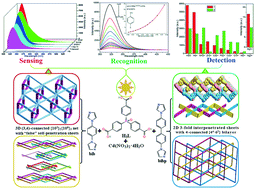Two cadmium coordination polymers based on tris(p-carboxyphenyl) phosphane oxide with highly selective sensing of nitrobenzene derivatives and Hg2+ cations†
Abstract
Two coordination polymers (CPs), namely, [Cd1/2(L)1/3(bib)1/2(H2O)]n (1) and {[Cd2(HL)2(bibp)2]·3H2O}n (2), have been assembled from the tripodal ligand tris(p-carboxyphenyl)phosphane oxide (H3L) with the help of 1,4-bis(imidazol-1-yl)benzene (bib) or 4,4′-bis(imidazol-1-yl)biphenyl (bibp). Structural analyses revealed that complex 1 is an unprecedented (3,4)-connected {103}2{106}3 net with 2D [Cd3(L)2]n sheets arranged in an ABCA′B′C′A′′B′′C′′ fashion. Complex 2 exhibits 3-fold interpenetrated sheets with a 4-connected {44·62}-sql sheet. Structural comparison reveals that the length of bis(imidazole) ancillary linkers plays a critical role in determining the structures and topologies. To our delight, fluorescence measurements show that the two Cd(II) CPs can selectively and sensitively detect Hg2+ cations and nitrobenzene derivatives (nitrobenzene, p-nitrotoluene, p-nitroaniline, and p-nitrophenol), which suggests that the two Cd(II) CPs are promising bifunctional luminescence sensor materials that could sense metal ions and small organic molecules.



 Please wait while we load your content...
Please wait while we load your content...